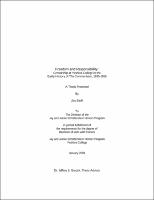Please use this identifier to cite or link to this item:
https://hdl.handle.net/20.500.12202/4256Full metadata record
| DC Field | Value | Language |
|---|---|---|
| dc.contributor.advisor | Dr. Jeffrey S. Gurock, Thesis Advisor | en_US |
| dc.contributor.author | Eleff, Zev | |
| dc.date.accessioned | 2018-11-14T20:55:00Z | |
| dc.date.available | 2018-11-14T20:55:00Z | |
| dc.date.issued | 2009-01 | |
| dc.identifier.uri | https://hdl.handle.net/20.500.12202/4256 | |
| dc.identifier.uri | https://ezproxy.yu.edu/login?url=https://repository.yu.edu/handle/20.500.12202/4256 | |
| dc.description | The file is restricted for YU community access only. | |
| dc.description.abstract | The first undergraduate newspaper was established at Dartmouth College in 1799. The Dartmouth Gazette, to which Daniel Webster contributed in his college days, ran as a weekly publication until 1820. The Yale Daily News was the first everyday college paper starting in 1873. The Harvard Crimson traces its origins to that same year but did not become a daily until 1883. Another storied news journal, Columbia’s Spectator was established in 1877 but did not establish itself as a daily for nearly 25 years. By the end of the century, most colleges had a student newspaper.1 By the close of the 1920s, there were at least 37 colleges which published daily news journals. Midwest college newspapers like University of Wisconsin’s Daily Cardinal and the Minnesota Daily, with circulations near 10,000, functioned like small city newspapers covering a wide range of news interests. The East Coast college papers generally restricted themselves to campus news, and consequently, their circulations were much smaller. Until the third decade of the twentieth century, covering the campus beat meant writing on sports, fraternity events and hazings. Perhaps if they were fortunate enough these collegiate journalists would scoop the local newspapers to reveal the university president’s new plan to build more study halls and dormitories to accommodate the influx of student enrollment felt at colleges campuses nationwide. Hardly any headlines in the college press reflected student discontent or any sort of affront to college officials.2 By the 1930s, however, the life of a college newsman became something very different. As a result of increased student radicalism on campuses, student newspapers waged an editorial war against their administrations. Whereas in the first quarter of the century when editors would seldom take issue with curricula and tenure appointments, suddenly hardly a week could go by without some campus newspaper taking issue with its university’s policies. In the Manhattan college scene alone, City College’s Campus and The Spectator of Columbia became famous for leading student strikes to pressure their respective administrations on a variety of campus related issues. In kind, outcry from student newspapers at this time led to doling out of suspensions and even expulsion of editors from time to time. This was the college culture into which Yeshiva College’s student newspaper, The Commentator, was born. | en_US |
| dc.description.sponsorship | Jay and Jeanie Schottenstein Honors Program | en_US |
| dc.language.iso | en_US | en_US |
| dc.publisher | Yeshiva College | en_US |
| dc.rights | Attribution-NonCommercial-NoDerivs 3.0 United States | * |
| dc.rights.uri | http://creativecommons.org/licenses/by-nc-nd/3.0/us/ | * |
| dc.subject | College student newspapers and periodicals --New York (State) --New York --History. | en_US |
| dc.subject | Censorship. | en_US |
| dc.subject | Yeshiva College --Periodicals --History. | en_US |
| dc.subject | Yeshiva College --Newspapers --History. | en_US |
| dc.subject | Commentator. | en_US |
| dc.title | Freedom and Responsibility: Censorship at Yeshiva College in the Early History of The Commentator, 1935-1958 | en_US |
| dc.type | Thesis | en_US |
| Appears in Collections: | Jay and Jeanie Schottenstein Honors Student Theses | |
Files in This Item:
| File | Description | Size | Format | |
|---|---|---|---|---|
| Zev-Eleff.pdf Restricted Access | 420.65 kB | Adobe PDF |  View/Open |
This item is licensed under a Creative Commons License

